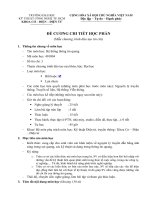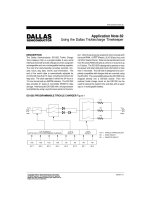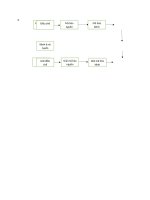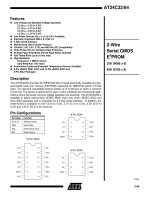Điện tử viễn thông lect12 1 khotailieu
Bạn đang xem bản rút gọn của tài liệu. Xem và tải ngay bản đầy đủ của tài liệu tại đây (278.47 KB, 29 trang )
12. Traffic engineering
lect12.ppt
S-38.1145 – Introduction to Teletraffic Theory – Spring 2006
1
12. Traffic engineering
Contents
•
•
•
•
Topology
Traffic matrix
Traffic engineering
Load balancing
2
12. Traffic engineering
Topology
•
•
•
A telecommunication network
consists of nodes and links
– Let N denote the set of nodes
indexed with n
– Let J denote the set of nodes
indexed with j
Example:
– N = {a,b,c,d,e}
– J = {1,2,3,…,12}
– link 1 from node a to node b
– link 2 from node b to node a
3
b
1
c
4
2
a
9
6
5
11
10
12
8
d
7
e
Let cj denote the capacity of link
j (bps)
3
12. Traffic engineering
Paths
•
We define a path (= route) as a
– set of consecutive links
connecting two nodes
– Let P denote the set of paths
indexed with p
•
Example:
– three paths from node a to
node c:
• red path consisting of
links 1 and 3
• green path consisting of
links 11 and 6
• blue path consisting of
links 10, 8 and 6
3
b
1
c
4
2
a
9
6
5
11
10
12
8
d
7
e
4
12. Traffic engineering
Path matrix
•
•
•
Each path consists of a set of
links
This connection is described by
the path matrix A,for which
– element ajp = 1 if j ∈ p, that is,
link j belongs to path p
– otherwise ajp = 0
Example:
– three columns of a path matrix
1
2
3
4
5
6
7
8
9
10
11
12
ac1
1
0
1
0
0
0
0
0
0
0
0
0
ac2
0
0
0
0
0
1
0
0
0
0
1
0
ac3
0
0
0
0
0
1
0
1
0
1
0
0
5
12. Traffic engineering
Shortest paths
•
If each link j is associated with a
correponding weight wj, the
length lp of path p is given by
lp = ∑ wj
j∈ p
– With unit link weights wj = 1,
path length = hop count
•
Example:
w=1
w=1
c
b
w=1
w=1
w=1
w=1
w=1
d
w=1
a
w=1w=1
w=1
e
w=1
– two shortest paths (of length 2)
from node a to node c
6
12. Traffic engineering
Contents
•
•
•
•
Topology
Traffic matrix
Traffic engineering
Load balancing
7
12. Traffic engineering
Traffic characterisation
Traffic
Circuit-switched
Packet-switched
e.g. telephone traffic
e.g. data traffic
Link
Network
Link
Network
8
12. Traffic engineering
Traffic matrix (1)
•
Traffic in a network is described
by the traffic matrix T, for which
– element tnm tells the traffic
demand (bps) from origin node
n to destination node m
– Aggregated traffic of all flows
with the same origin and
destination
– Aggregated traffic during a time
interval, e.g. busy hour or
”typical 5-minute interval”
•
c
b
tac
d
a
e
Example:
– Traffic demand from origin a to
destination c is tac (bps)
9
12. Traffic engineering
Traffic matrix (2)
•
Below we present the traffic
demands in a vector form
– Let K denote the set of origindestination pairs (OD-pairs)
indexed with k
•
•
Traffic demands constitute a
vector x, for which
– element xk tells the traffic
demand of OD-pair k
Example:
– if OD-pair (a,c) is indexed with k,
then xk = tac
c
b
xk
d
a
e
10
12. Traffic engineering
Contents
•
•
•
•
Topology
Traffic matrix
Traffic engineering
Load balancing
11
12. Traffic engineering
Traffic engineering and network design
•
Traffic engineering = ”Engineer the traffic to fit the topology”
– Given a fixed topology and a traffic matrix, how to route these traffic
demands?
•
Network design = ”Engineer the topology to fit the traffic”
12
12. Traffic engineering
Effect of routing on load distribution
•
Routing algorithm determines
how the traffic load is distributed
to the links
– Internet routing protocols (RIP,
OSPF, BGP) apply the shortest
path algorithms (Bellman-Ford,
Dijkstra)
– In MPLS networks, other
algorithms are also possible
•
More precisely: routing algorithm
determines the proportions
(splitting ratios) φpk of traffic
demands xk allocated to paths p,
b
φ = 1/2
c
x
φ = 1/2
a
d
φ=0
e
∑ φ pk = 1 for all k
p∈P
13
12. Traffic engineering
Link counts
•
Traffic on a path p between
OD-pair k is thus
y = x/2
φ pk xk
•
Link counts yj are determined
by traffic demands xk and
splitting ratios φpk:
y j = ∑ ∑ a jpφ pk xk
b
y = x/2
y = x/2
x
y = x/2
a
y=0
c
d
y=0
e
p∈P k∈K
•
The same in matrix form:
y = Aφx
14
12. Traffic engineering
MPLS
•
MPLS (Multiprotocol Label Switching) supports traffic load distribution
to parallel paths between OD-pairs
– In MPLS networks, there can be any number of parallel Label Switched
Paths (LSP) between OD-pairs
– These paths do not need to belong to the set of shortest paths
– Each LSP is associated with a label and each MPLS packet is tagged with
such a label
•
•
MPLS packets are routed through the network via these LSP’s
(according to their label)
Traffic load distribution can be affected directly by changing the
splitting ratios φpk at the origin nodes
15
12. Traffic engineering
OSPF (1)
•
•
OSPF (Open Shortest Path First) is an intradomain routing protocol in
IP networks
Link State Protocol
– each node tells the other nodes the distance to its neighbouring nodes
– these distances are the link weights for the shortest path algorithm
– based on this information, each node is aware of the whole topology of the
domain
– the shortest paths are derived from this topology using Dijkstra’s algorithm
•
IP packets are routed through the network via these shortest paths
16
12. Traffic engineering
OSPF (2)
•
Routers in OSPF networks typically apply ECMP (Equal Cost Multipath)
– If there are multiple shortest paths from node n to node m, then node n tries
to split the traffic uniformly to those outgoing links that belong to at least one
of these shortest paths
– However, this does not imply that the traffic load is distributed uniformly to
all shortest paths! See the example on next slide.
•
Traffic load distribution can be affected only indirectly by changing the
link weights
– splitting ratios φpk can not directly be changed
– due to ECMP, the desired splitting ratios φpk may be out of reach
17
12. Traffic engineering
ECMP
y = x/4
y = x/2
b
y = x/4
a
y = x/2
d
x
c
y = x/2
y = x/4
e
y = x/4
f
φ = 1/4 d
g
y = x/2
b
φ = 1/4 e
a
c
φ = 1/2
g
f
18
12. Traffic engineering
Effect of link weights on load distribution (1)
maximum
link load
w=1
φ = 1/2
w=1
c
b
w=1
w=1
w
=
1
w=1 x
w=1
d
a
x w=1
w=1w=1
w=1
e
w=1
b
y = 3x/2
φ = 1/2
b
y = x/2
y = x/2
d
c
d
a
a
φ=1
y = x/2
c
e
y=x
e
19
12. Traffic engineering
Effect of link weights on load distribution (2)
maximum
link load
w=1
φ = 1/2
w=1
c
b
w=1
w=1
w
=
1
w=1 x
w=1
d
a
x w=2
w=1w=1
w=1
e
w=2
b
y = x/2
c
b
y=x
φ = 1/2
a
φ = 1/2
d
φ = 1/2
e
c
y = x/2
y=x
y = x/2
a
y = x/2
d
y = x/2
e
link weight
increased
20
12. Traffic engineering
Contents
•
•
•
•
Topology
Traffic matrix
Traffic engineering
Load balancing
21
12. Traffic engineering
Load balancing problem (1)
•
•
Given a fixed topology and a
traffic matrix, how to optimally
route these traffic demands?
One approach is to equalize the
relative load of different links,
x=1
c=1 b c=1 c=1 e c=1
a
d
g
c=1 c c=1 c=1 f c=1
ρj = yj/cj
– Sometimes this can be done in
multiple ways (upper figure)
– Sometimes it is not possible at
all (lower figure)
– In this case, we may, however,
try to get as close as possible,
e.g. by minimizing the maximum
relative link load (called: load
balancing problem)
x=1
c=1 b c=1
a
d
c=1 c c=2
22
12. Traffic engineering
Load balancing problem (2)
•
Load Balancing Problem:
– Consider a network with topology (N,J), link capacities cj, and traffic
demands xk. Determine the splitting ratios φpk so that the maximum relative
link load is minimized
Minimize
yj
max c
j∈J j
y j = ∑ ∑ A jpφ pk xk ∀j ∈ J
p∈P k∈K
subject to ∑ φ pk = 1
∀k ∈ K
p∈P
φ pk ≥ 0
∀p ∈ P, k ∈ K
23
12. Traffic engineering
Load balancing problem (3)
•
•
Load Balancing Problem has
always a solution but this might
not be unique
Example:
– the same maximum link load is
achieved with routes of different
length
– the upper routes are better due
to smaller capacity consumption
•
A reasonable unique solution is
achieved by associating a
negligible cost with all the hops
along the paths used
y = x/2
b
c
y = x/2
x
y = x/2
y = x/2
d
a
y=0
y=0
e
y = x/2
b
y = x/2
y = x/2
x
y=0
a
y = x/2
c
d
y = x/2
e
24
12. Traffic engineering
Load balancing problem (4)
•
Load Balancing Problem with a reasonable and unique solution:
– Consider a network with topology (N,J), link capacities cj, and traffic
demands xk. Determine the splitting ratios φpk so that the maximum relative
link load is minimized with the smallest amount of required capacity
Minimize
yj
max + ε ∑ y j '
j∈J c j
j '∈J
y j = ∑ ∑ A jpφ pk xk ∀j ∈ J
p∈P k∈K
subject to ∑ φ pk = 1
∀k ∈ K
p∈P
φ pk ≥ 0
∀p ∈ P, k ∈ K
25









